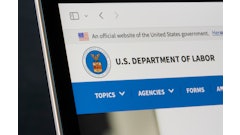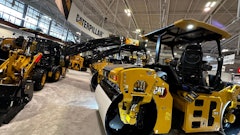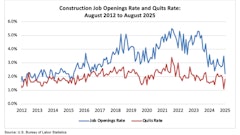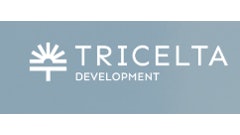
As prices for materials, equipment, labor and shipping continue to increase due to unprecedented inflation in the United States as well as various supply chain crises, both nonresidential and residential construction timelines continue to lengthen. In general, a universal truth when analyzing a labor shortage: productivity declines when the labor supply is tight. In short, projects are more expensive and taking way longer than they should to complete.
“Construction employment has stalled in many states, even though contractors have plenty of projects needing more employees, due to a dearth of qualified workers,” said Ken Simonson, chief economist for the Associated General Contractors of America (AGC), regarding an analysis of federal employment data the AGC released in late July 2022. “Only half the states had an increase in construction employment last month.”
In this recurring Bridging the Gap series, experts have covered simulators to help new employees get to know their future jobs better, the concept of investing in training new and current employees and the idea of spinning construction as a technology job for Gen Z workers. This column touched on automation of subcontractor roles, such as scheduling, payments and documentation. It has touted the Infrastructure Investment and Jobs Act (IIJA) as an excellent opportunity for job building in the United States. It’s also given out practical tips for outreach to potential employees—from offering part-time work to retirees to old-school paper job postings at local haunts.
What it has not touched on as much is revolutionizing a work culture through destigmatizing the preconceived notion of construction as a dirty, undesirable or dead-end job. This month, here are some back-to-basics tips for changing the oft-negative conversation around construction as a career into a positive dialogue:
Say this: “This is an active and rewarding job. You can be outside and work while being physically active, while still getting the intellectual stimulation of analyzing jobsites, problem solving on the fly and being detail oriented.”
Not: “This is a hard job, and you’ll need to be comfortable with grime, dirt and possible injuries.”
The world needs buildings and roads for infrastructure, as well as multi-family residential buildings to solve a nationwide housing crisis and affordability problem. Construction workers are vital to that progress. What’s more, many people in the U.S. workforce are not meant to sit at a computer, hammer-typing out thousands of chats or emails daily; their skills are better suited to hands-on work and building, whether fine-tuning jobsite plans or running high-tech equipment. The physical satisfaction of these opportunities is what construction hiring managers should tout.
Say this: “You’ll get to know and operate incredible equipment, and increased technology has made these machines comfortable, efficient and much safer.”
Not: “Anyone can be an operator.”
While it may be true that most inexperienced new employees can be trained to become excellent operators, the emphasis during the interview and onboarding process should be on the career opportunity and workplace environment. New employees will be paid somewhere between 3.4 to 4.17% more than employees hired before 2022, according to the latest Contractor Compensation Quarterly (CCQ) published by PAS, Inc., as reported by more than 340 companies in the 40th edition of the Construction / Construction Management Staff Salary Survey. These higher-paid employees are eager for increased autonomy, work-life balance, and a safe, comfortable, positive work environment, according to a March 2022 McKinsey report, “Bridging the Labor Mismatch in U.S. Construction.” The implication that they are expendable or disposable as employees will not work in hiring managers’ favors. A hiring manager should aim to seek employees who fit well within the workplace culture, rather than simply a warm body to run equipment.
Say this: “Training for a construction career can be an excellent alternative to traditional four-year college or university. And it can be like a tech job on certain jobsites, due to the automation of high-level machines.”
Not: “If you don’t have a degree, you might as well get a job in construction and make some money.”
Making a living wage is important, but upward mobility and feeling valued at a company matter to most people. Rather than phrase recruitment advertising with an “oh well” tone that indicates HR believes construction is a dead-end job, focus on the benefits, both intellectual and monetary. The lack of student loan debt alone can place young construction workers far ahead of their Gen Z peers financially. Additionally, those higher-paying jobs, with more disposable income available sans student loan debt, are also safer and more engaging than in the past. The increased automation and machine control of higher-tech equipment, from 3D guidance to automated dozers to cold-framed steel (CFS) automations and prefabricated options, allow new employees to learn both the technology and the trade, resulting in an ultimately more robust, educated workforce.
Say this: “If you like statistics, estimating is a great way to break into the construction industry.”
Not: “There aren’t opportunities in construction for people who don’t want to work on jobsites.”
There are ample opportunities for those interested in the administrative, accounting and other office-based tasks of construction, too.
Say this: “The U.S. government is actively working with construction associations and companies to provide pathways into the construction industry for women, people of color and immigrants.”
Not: “You might feel left out in this industry.”
Currently, 88 percent of the construction sector’s workforce is white and 89% is male, according to the March 2022 McKinsey report, “Bridging the labor mismatch in U.S. construction.” Attracting more diverse talent as quickly as possible is imperative, and employers should consider working with nontraditional sources of talent, according to McKinsey, like veteran-transition programs, formerly incarcerated individuals and immigrants.
AGC officials recently called on the U.S. government to allow employers to sponsor more foreign-born workers and support increased career and technical education to broaden options for workers to hone construction skills. Similarly, the federal government’s IIJA should spur training partnerships within the recently announced Talent Pipeline Challenge, which the White House aims to use to build pathways to quality jobs for women, people of color and underserved workers—including those from rural and tribal communities and people who live in consistent poverty. Christopher Herbert, the managing director for Harvard University’s Joint Center for Housing Studies, told the U.S. House of Representatives Ways and Means committee at its July 13 hearing that the construction industry talent pool must expand to include more women and immigrants. In 2021, approximately 25% of all U.S.-based construction workers were immigrants, according to the National Association of Homebuilders. Immigration reform, Herbert said, would be a way to amp up the supply of workers available for builders to hire and speed up the currently way-overdue construction timelines in the United States.
The opportunities for nontraditional employees are growing at an exponential rate, creating the potential for a much more diverse construction sector workforce than ever before. Recruiters and employers now need to ensure their recruitment communications, interview and hiring techniques, and onboarding processes are fully articulated and as inclusive as possible, as they make these new, much-needed hires.




















